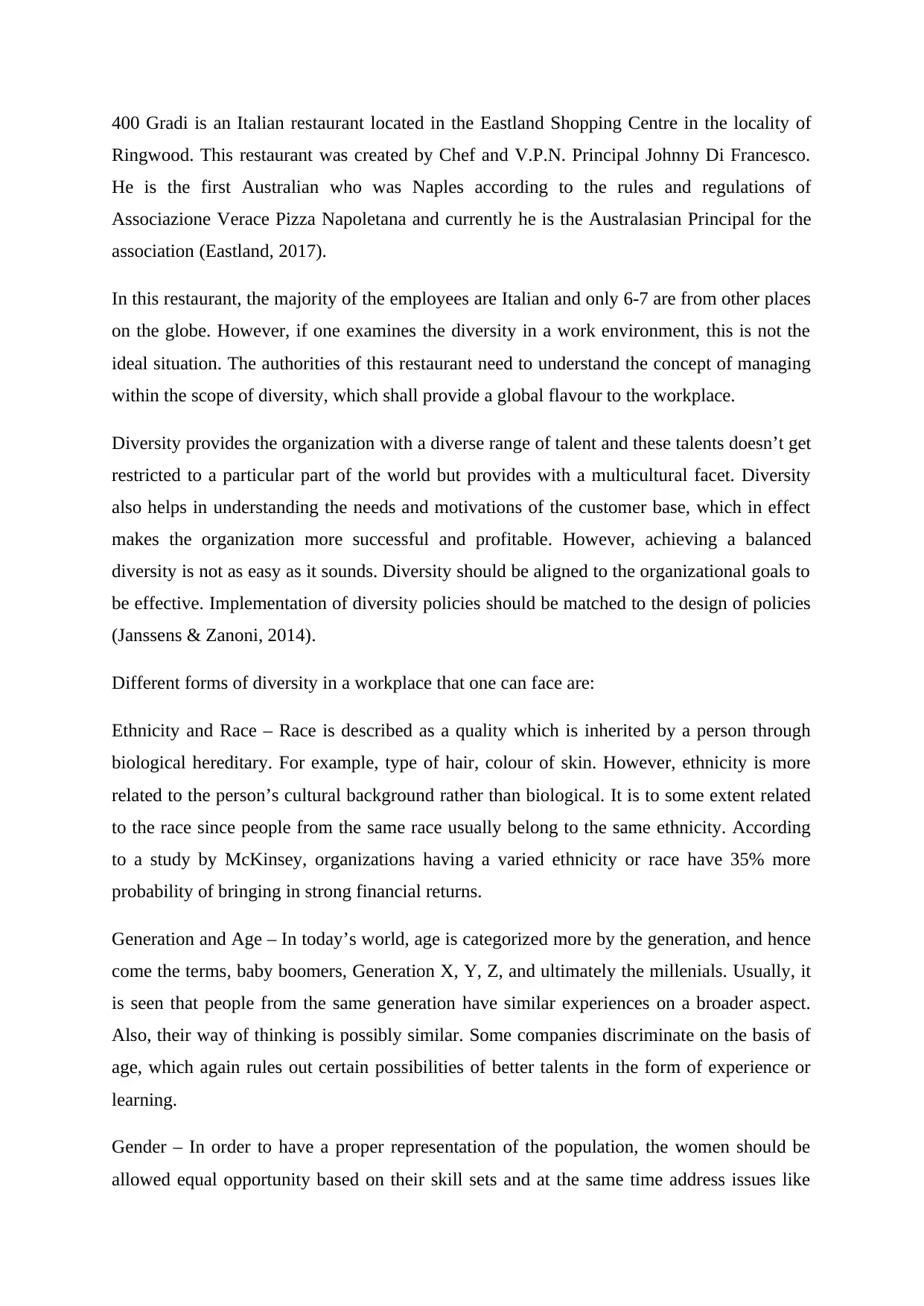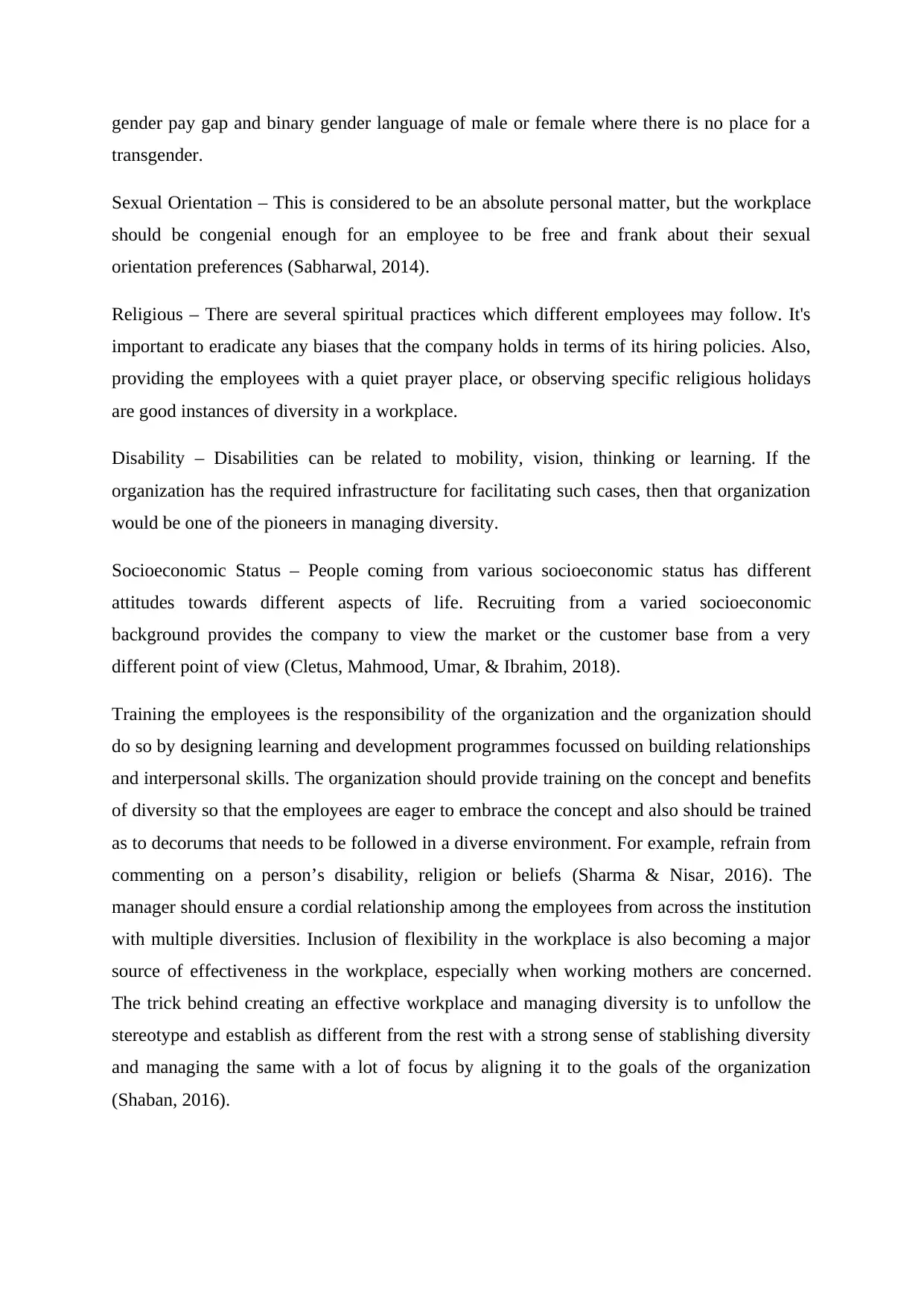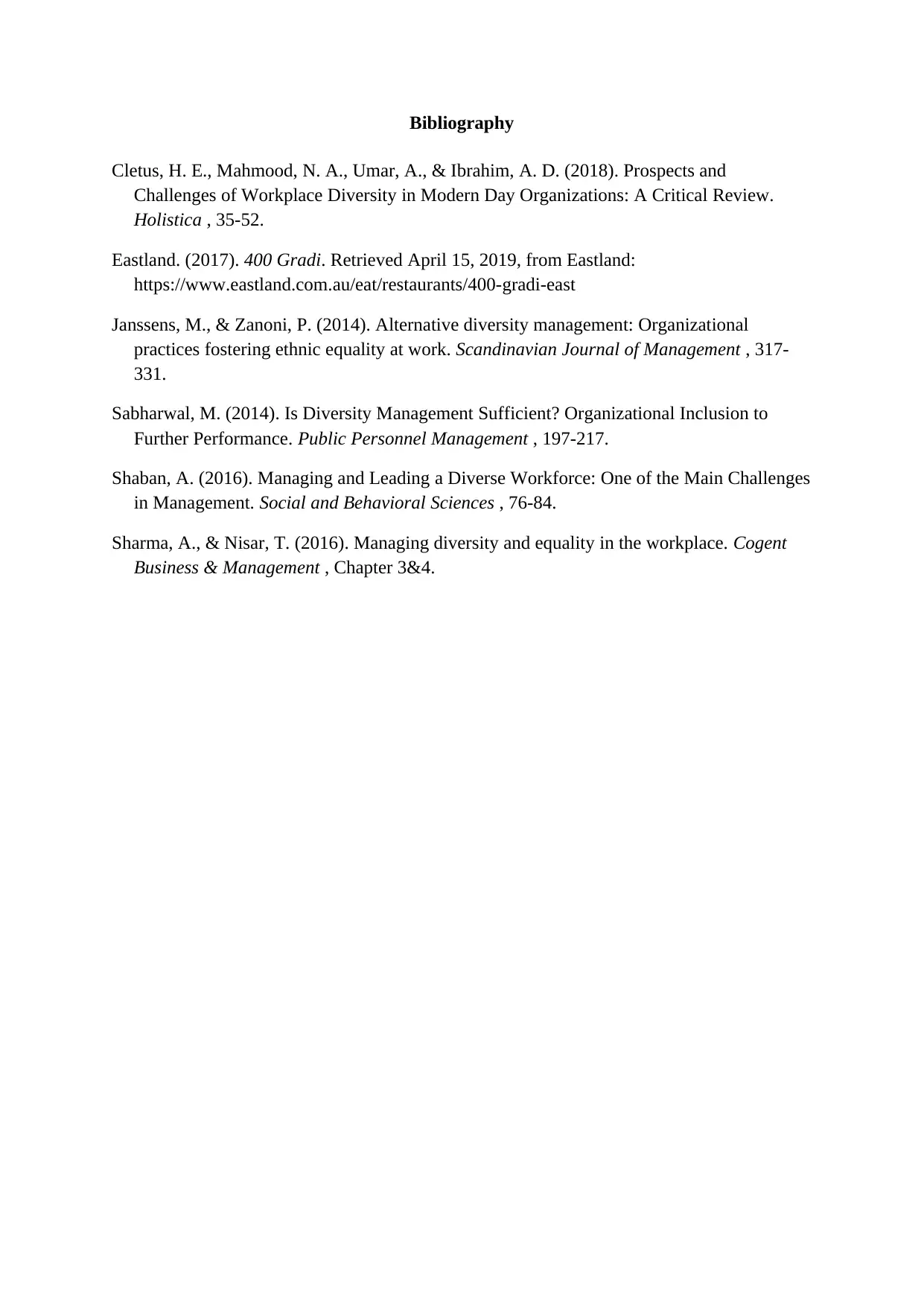Comprehensive Report: Diversity Management in the 400 Gradi Restaurant
VerifiedAdded on 2023/01/19
|3
|1052
|86
Report
AI Summary
This report analyzes the diversity management practices at the 400 Gradi Italian restaurant in Ringwood, Australia. The restaurant, founded by Johnny Di Francesco, currently has a workforce predominantly comprised of Italian employees. The report emphasizes the importance of embracing diversity in the workplace, highlighting various dimensions such as ethnicity, age, gender, sexual orientation, religion, disability, and socioeconomic status. It discusses the benefits of a diverse workforce, including increased financial returns, better understanding of customer needs, and a more global perspective. The report suggests implementing training programs focused on building interpersonal skills and fostering an inclusive environment. The report also emphasizes the need for flexibility and aligning diversity policies with organizational goals to create an effective and successful workplace. The report concludes by mentioning various scholarly sources to support the arguments and recommendations.

400 Gradi is an Italian restaurant located in the Eastland Shopping Centre in the locality of
Ringwood. This restaurant was created by Chef and V.P.N. Principal Johnny Di Francesco.
He is the first Australian who was Naples according to the rules and regulations of
Associazione Verace Pizza Napoletana and currently he is the Australasian Principal for the
association (Eastland, 2017).
In this restaurant, the majority of the employees are Italian and only 6-7 are from other places
on the globe. However, if one examines the diversity in a work environment, this is not the
ideal situation. The authorities of this restaurant need to understand the concept of managing
within the scope of diversity, which shall provide a global flavour to the workplace.
Diversity provides the organization with a diverse range of talent and these talents doesn’t get
restricted to a particular part of the world but provides with a multicultural facet. Diversity
also helps in understanding the needs and motivations of the customer base, which in effect
makes the organization more successful and profitable. However, achieving a balanced
diversity is not as easy as it sounds. Diversity should be aligned to the organizational goals to
be effective. Implementation of diversity policies should be matched to the design of policies
(Janssens & Zanoni, 2014).
Different forms of diversity in a workplace that one can face are:
Ethnicity and Race – Race is described as a quality which is inherited by a person through
biological hereditary. For example, type of hair, colour of skin. However, ethnicity is more
related to the person’s cultural background rather than biological. It is to some extent related
to the race since people from the same race usually belong to the same ethnicity. According
to a study by McKinsey, organizations having a varied ethnicity or race have 35% more
probability of bringing in strong financial returns.
Generation and Age – In today’s world, age is categorized more by the generation, and hence
come the terms, baby boomers, Generation X, Y, Z, and ultimately the millenials. Usually, it
is seen that people from the same generation have similar experiences on a broader aspect.
Also, their way of thinking is possibly similar. Some companies discriminate on the basis of
age, which again rules out certain possibilities of better talents in the form of experience or
learning.
Gender – In order to have a proper representation of the population, the women should be
allowed equal opportunity based on their skill sets and at the same time address issues like
Ringwood. This restaurant was created by Chef and V.P.N. Principal Johnny Di Francesco.
He is the first Australian who was Naples according to the rules and regulations of
Associazione Verace Pizza Napoletana and currently he is the Australasian Principal for the
association (Eastland, 2017).
In this restaurant, the majority of the employees are Italian and only 6-7 are from other places
on the globe. However, if one examines the diversity in a work environment, this is not the
ideal situation. The authorities of this restaurant need to understand the concept of managing
within the scope of diversity, which shall provide a global flavour to the workplace.
Diversity provides the organization with a diverse range of talent and these talents doesn’t get
restricted to a particular part of the world but provides with a multicultural facet. Diversity
also helps in understanding the needs and motivations of the customer base, which in effect
makes the organization more successful and profitable. However, achieving a balanced
diversity is not as easy as it sounds. Diversity should be aligned to the organizational goals to
be effective. Implementation of diversity policies should be matched to the design of policies
(Janssens & Zanoni, 2014).
Different forms of diversity in a workplace that one can face are:
Ethnicity and Race – Race is described as a quality which is inherited by a person through
biological hereditary. For example, type of hair, colour of skin. However, ethnicity is more
related to the person’s cultural background rather than biological. It is to some extent related
to the race since people from the same race usually belong to the same ethnicity. According
to a study by McKinsey, organizations having a varied ethnicity or race have 35% more
probability of bringing in strong financial returns.
Generation and Age – In today’s world, age is categorized more by the generation, and hence
come the terms, baby boomers, Generation X, Y, Z, and ultimately the millenials. Usually, it
is seen that people from the same generation have similar experiences on a broader aspect.
Also, their way of thinking is possibly similar. Some companies discriminate on the basis of
age, which again rules out certain possibilities of better talents in the form of experience or
learning.
Gender – In order to have a proper representation of the population, the women should be
allowed equal opportunity based on their skill sets and at the same time address issues like
Paraphrase This Document
Need a fresh take? Get an instant paraphrase of this document with our AI Paraphraser

gender pay gap and binary gender language of male or female where there is no place for a
transgender.
Sexual Orientation – This is considered to be an absolute personal matter, but the workplace
should be congenial enough for an employee to be free and frank about their sexual
orientation preferences (Sabharwal, 2014).
Religious – There are several spiritual practices which different employees may follow. It's
important to eradicate any biases that the company holds in terms of its hiring policies. Also,
providing the employees with a quiet prayer place, or observing specific religious holidays
are good instances of diversity in a workplace.
Disability – Disabilities can be related to mobility, vision, thinking or learning. If the
organization has the required infrastructure for facilitating such cases, then that organization
would be one of the pioneers in managing diversity.
Socioeconomic Status – People coming from various socioeconomic status has different
attitudes towards different aspects of life. Recruiting from a varied socioeconomic
background provides the company to view the market or the customer base from a very
different point of view (Cletus, Mahmood, Umar, & Ibrahim, 2018).
Training the employees is the responsibility of the organization and the organization should
do so by designing learning and development programmes focussed on building relationships
and interpersonal skills. The organization should provide training on the concept and benefits
of diversity so that the employees are eager to embrace the concept and also should be trained
as to decorums that needs to be followed in a diverse environment. For example, refrain from
commenting on a person’s disability, religion or beliefs (Sharma & Nisar, 2016). The
manager should ensure a cordial relationship among the employees from across the institution
with multiple diversities. Inclusion of flexibility in the workplace is also becoming a major
source of effectiveness in the workplace, especially when working mothers are concerned.
The trick behind creating an effective workplace and managing diversity is to unfollow the
stereotype and establish as different from the rest with a strong sense of stablishing diversity
and managing the same with a lot of focus by aligning it to the goals of the organization
(Shaban, 2016).
transgender.
Sexual Orientation – This is considered to be an absolute personal matter, but the workplace
should be congenial enough for an employee to be free and frank about their sexual
orientation preferences (Sabharwal, 2014).
Religious – There are several spiritual practices which different employees may follow. It's
important to eradicate any biases that the company holds in terms of its hiring policies. Also,
providing the employees with a quiet prayer place, or observing specific religious holidays
are good instances of diversity in a workplace.
Disability – Disabilities can be related to mobility, vision, thinking or learning. If the
organization has the required infrastructure for facilitating such cases, then that organization
would be one of the pioneers in managing diversity.
Socioeconomic Status – People coming from various socioeconomic status has different
attitudes towards different aspects of life. Recruiting from a varied socioeconomic
background provides the company to view the market or the customer base from a very
different point of view (Cletus, Mahmood, Umar, & Ibrahim, 2018).
Training the employees is the responsibility of the organization and the organization should
do so by designing learning and development programmes focussed on building relationships
and interpersonal skills. The organization should provide training on the concept and benefits
of diversity so that the employees are eager to embrace the concept and also should be trained
as to decorums that needs to be followed in a diverse environment. For example, refrain from
commenting on a person’s disability, religion or beliefs (Sharma & Nisar, 2016). The
manager should ensure a cordial relationship among the employees from across the institution
with multiple diversities. Inclusion of flexibility in the workplace is also becoming a major
source of effectiveness in the workplace, especially when working mothers are concerned.
The trick behind creating an effective workplace and managing diversity is to unfollow the
stereotype and establish as different from the rest with a strong sense of stablishing diversity
and managing the same with a lot of focus by aligning it to the goals of the organization
(Shaban, 2016).

Bibliography
Cletus, H. E., Mahmood, N. A., Umar, A., & Ibrahim, A. D. (2018). Prospects and
Challenges of Workplace Diversity in Modern Day Organizations: A Critical Review.
Holistica , 35-52.
Eastland. (2017). 400 Gradi. Retrieved April 15, 2019, from Eastland:
https://www.eastland.com.au/eat/restaurants/400-gradi-east
Janssens, M., & Zanoni, P. (2014). Alternative diversity management: Organizational
practices fostering ethnic equality at work. Scandinavian Journal of Management , 317-
331.
Sabharwal, M. (2014). Is Diversity Management Sufficient? Organizational Inclusion to
Further Performance. Public Personnel Management , 197-217.
Shaban, A. (2016). Managing and Leading a Diverse Workforce: One of the Main Challenges
in Management. Social and Behavioral Sciences , 76-84.
Sharma, A., & Nisar, T. (2016). Managing diversity and equality in the workplace. Cogent
Business & Management , Chapter 3&4.
Cletus, H. E., Mahmood, N. A., Umar, A., & Ibrahim, A. D. (2018). Prospects and
Challenges of Workplace Diversity in Modern Day Organizations: A Critical Review.
Holistica , 35-52.
Eastland. (2017). 400 Gradi. Retrieved April 15, 2019, from Eastland:
https://www.eastland.com.au/eat/restaurants/400-gradi-east
Janssens, M., & Zanoni, P. (2014). Alternative diversity management: Organizational
practices fostering ethnic equality at work. Scandinavian Journal of Management , 317-
331.
Sabharwal, M. (2014). Is Diversity Management Sufficient? Organizational Inclusion to
Further Performance. Public Personnel Management , 197-217.
Shaban, A. (2016). Managing and Leading a Diverse Workforce: One of the Main Challenges
in Management. Social and Behavioral Sciences , 76-84.
Sharma, A., & Nisar, T. (2016). Managing diversity and equality in the workplace. Cogent
Business & Management , Chapter 3&4.
⊘ This is a preview!⊘
Do you want full access?
Subscribe today to unlock all pages.

Trusted by 1+ million students worldwide
1 out of 3
Related Documents
Your All-in-One AI-Powered Toolkit for Academic Success.
+13062052269
info@desklib.com
Available 24*7 on WhatsApp / Email
![[object Object]](/_next/static/media/star-bottom.7253800d.svg)
Unlock your academic potential
Copyright © 2020–2025 A2Z Services. All Rights Reserved. Developed and managed by ZUCOL.





